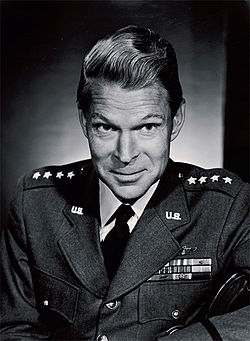- Lauris Norstad
-
Lauris Norstad 
General Lauris NorstadBorn March 24, 1907
Minneapolis, MinnesotaDied September 12, 1988 (aged 81) Allegiance United States of America Service/branch United States Air Force Years of service 1930-1963 Rank  General
GeneralCommands held Supreme Allied Commander Europe Battles/wars World War II Awards Air Force Distinguished Service Medal (2)
Silver Star
Legion of Merit (2)
Air Medal
French Legion of HonorLauris Norstad (March 24, 1907 – September 12, 1988) was an American General in the United States Army Air Forces and United States Air Force.
Contents
Early life and military career
Lauris Norstad was born in Minneapolis, Minnesota, in 1907. He graduated from the United States Military Academy June 12, 1930 and was commissioned a second lieutenant of Cavalry. In September 1930, he entered Primary Flying School at March Field, California, and graduated from Advanced Flying School and was transferred to the Air Corps in June 1931. Going to Schofield Barracks, Hawaii, in January 1932, he was assigned to the 18th Pursuit Group, assuming command of it in July 1933. In March 1936 he was named adjutant of the Ninth Bomb Group there. Entering the "short course" the Air Corps Tactical School at Maxwell Field, Alabama, in September 1939, he graduated three months later and returned to Mitchel Field as officer in charge of the 9th Bomb Group Navigation School.
Moving to Langley Field, Virginia, in July 1940, General Norstad was Adjutant of the 25th Bomb Group, and the following November he was named Assistant Chief of Staff for Intelligence of General Headquarters Air Force there. In February 1942 he was appointed a member of the Advisory Council to the commanding general of the Army Air Forces at Washington, D.C.
World War II
In August 1942, Norstad was named assistant chief of staff for operations of the 12th Air Force, going to England with it the following month in support of Operation Husky, and to Algiers, North Africa in October 1942.
In February 1943, he was promoted to Brigadier General and assumed the additional duty of assistant chief of staff for operations of the Northwest African Air Forces. In December 1943 he was appointed director of operations of the Mediterranean Allied Air Forces at Algiers, moving with it to Caserta, Italy, two months later.
Norstad was transferred to Washington, D.C. in August 1944, where he was deputy chief of Air Staff at Army Air Force Headquarters with added duty as chief of staff of the 20th Air Force. He was relieved of this additional duty May 8, 1945, and assumed additional duty as assistant chief of Air Staff for Plans at Army Air Force Headquarters. He was promoted to Major General the following month.
Relieved of assignment as chief of staff of the 20th Air Force in February 1946, he continued as assistant chief of air staff for plans until the following June, when he was appointed director of the Plans and Operations Division of the War Department at Washington, D.C.
On October 1, 1947, following the division of the War Department into the Departments of The Army and The Air Force, General Norstad was appointed deputy chief of staff for operations of the Air Force, and the following May assumed additional duty as acting vice chief of staff of the Air Force.
SHAPE Leadership
Joining the U.S. Air Forces in Europe in October 1950 General Norstad was commander in chief, USAFE, with Headquarters at Wiesbaden, Germany. On April 2, 1951 he assumed additional duty as commanding general of the Allied Air Forces in Central Europe under the Supreme Headquarters of the Allied Powers in Europe. He was designated air deputy to the supreme allied commander, Europe, SHAPE, on July 27, 1953.
Relieved of duty as air deputy to supreme allied commander, Europe November 20, 1956, the president appointed General Norstad to become Supreme Allied Commander Europe, and commander in chief, U.S. European Command. As such he initially encouraged France to develop its own nuclear capacity, but then defected on the idea once he grew disillusioned with French President Charles de Gaulle's interference with NATO.
His decorations included the Air Force Distinguished Service Medal with two oak leaf clusters, Silver Star, Legion of Merit with oak leaf cluster, Air Medal, and the French Legion of Honor by decision of General de Gaulle himself. He was rated a command pilot, combat observer, and technical observer.
General Norstad retired on December 31, 1963. He died on September 12, 1988.
References
Further reading
- Jordan, Robert S. Norstad: Cold War NATO Supreme Commander—Airman, Strategist, Diplomat St. Martin's Press, 2000. 350 pp.
External links
Military offices Preceded by
Sir Hugh SaundersAir Deputy to SACEUR
1953–1958Succeeded by
Leon W. JohnsonPreceded by
Gen. Alfred GruentherSupreme Allied Commander Europe (NATO)
1956—1963Succeeded by
Gen. Lyman LemnitzerEisenhower* • Ridgway • Gruenther • Norstad • Lemnitzer • Goodpaster • Haig • Rogers • Galvin • Shalikashvili • Joulwan • Clark • Ralston • Jones • Craddock • Stavridis - only Supreme Allied Commander
Categories:- 1907 births
- 1988 deaths
- United States Military Academy alumni
- United States Air Force generals
- American people of Norwegian descent
- American military personnel of World War II
- Recipients of the Distinguished Service Medal (United States)
- Recipients of the Silver Star
- Recipients of the Legion of Merit
- Légion d'honneur recipients
- Recipients of the Croix de Guerre (France)
- NATO Supreme Allied Commanders
- People from Minneapolis, Minnesota
- United States Army Air Forces generals
- Knights Grand Cross of the Order of St. Olav
Wikimedia Foundation. 2010.
